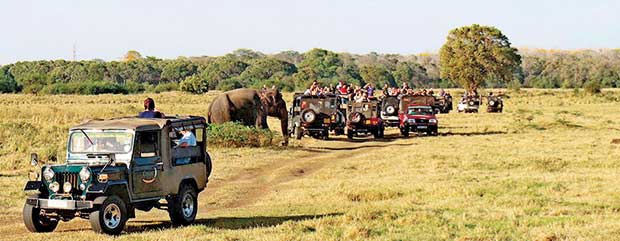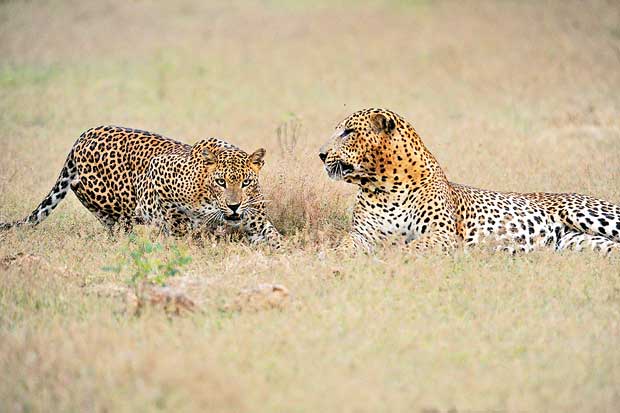Reply To:
Name - Reply Comment
Last Updated : 2024-05-10 12:42:00

Much has been written and said about Block 1 of Yala National Park and its over-visitation, causing disturbance and danger to wildlife, thus jeopardizing conservation. The latest decision to cap the number of jeeps entering Block 1 at 500 is unsustainable for obvious reasons. This decision was a response to a pushback from jeep drivers to a previous cap at 200 jeeps – that is, 100 in the morning, 100 in the evening. As a result of the pushback, that decision never really took off.
What I aim to do here is to share a few ideas on an alternative way of thinking about the problem, in the hope that it may broaden the scope of thinking and contribute towards a body of ideas that would culminate in a constructive and sustainable solution to the problem at hand. But first off, a disclaimer. I’m no wildlife expert. On the contrary, my experience is in policy and strategy. 
In my view, there are two types of approaches one can take towards influencing human behaviour. The first is what I call the Legislative Approach or rule-based approach. The second is what I call the Incentives Approach. The Legislative Approach takes the view that one must legislate or formulate a set of unbreakable rules to solve a problem, and once one does legislate or draw up a set of rules, enforcement alone will ensure adherence. Meanwhile, the Incentives Approach takes the view that human beings act in certain ways based on certain motivations and similarly, desist from acting in certain ways based on demotivation. In other words, human beings choose to behave or not to behave in a particular way based on incentives and disincentives to do so or not to do so.
The approach the authorities seem to have adopted is the Legislative Approach. The reaction was an almost spontaneous protest from heavily unionised jeep drivers, who see the capping of safari jeep entries to the park as negatively affecting their livelihoods. Given their level of organization, and resultant political lobby power in the Hambantota district, it is unlikely at this stage that the legislative approach will succeed in holding out as a sustainable solution to the problem. As long as the problem is framed as a battle between animal conservation and human livelihoods, there is little question in my view that the latter will prevail.
Alternatively, what if we used the incentives approach? Let’s remember that there are several entrances to the vast Yala National Park. Block 1 for instance, has two entrances – at Palatupana and Katagamuwa. Block 2 has restricted access, but Blocks 3 and 5 are accessible at Galge, off the Buttala-Kataragama road. However, road networks leave much to be desired in these blocks in comparison to Block 1, presumably leading to the popular view that leopards inhabit Block 1 more than any other areas of the park. But, as I am sure the experts would testify to, animals do not know boundaries on a map, so I don’t see how this view is plausible, given boundaries within the park are quite porous, and leopards, as I understand, are quite adaptable. Nevertheless, I can certainly see how the view has become somewhat entrenched in the popular psyche, given access roads to other parts are so poor, leading to under-visitation of these areas and over-visitation of Block 1.

What if the authorities funnelled financial and physical resources to develop the road networks in other parts of Yala, with the goal of bringing the networks on par with Yala Block 1 and Wilpattu? The drive between Tissamaharama (where many Yala jeep drivers are based) and Galge, for instance (where the entrances to Blocks 3 and 5 are located) takes 45 minutes – but that’s only 20 minutes more than that between Tissamaharama and Palatupana (where the entrance to Block 1 is located), which is presently the regular route for Tissamaharama-based drivers. This could presumably do three things: first, over time, it would serve as an incentive for jeep drivers in Tissamaharama to drive an extra 20 minutes to enter Block 3 or 5 at Galge for their safaris. Second, it could provide an alternative for Kataragama-based drivers to drive an extra 20 minutes (total journey under 30 minutes) to the Galge entrance. Third, it could probably help build up livelihood opportunities for people in the immediate vicinity of Galge, and north of it, towards Buttala.
But still, the elephant in the room remains. How does one incentivize drivers to leave Block 1 in order to enter Blocks 2 or 3, if they need to drive an extra 20 minutes to do so? Why not simply make it cheaper? Once road networks are sufficiently expanded in Blocks 3 and 5, it will take some time for animals to get used to the idea of vehicles in the park, which means, there will probably be a lag in the time duration between opening all the new roads and the regular sighting of animals. During this lag period, why not make it significantly cheaper to enter Blocks 3 and 5, for let’s say, a period of two years? This will help both jeep drivers/tourists and wildlife to get used to the idea of jeep visitation of these blocks.
Meanwhile, what if jeeps numbering beyond a stipulated capped number were charged extra (let’s say double for the sake of argument) if they still wished to enter Block 1? In other words, what if we rescinded the fixed number cap, but introduced a sizable surcharge instead for those that still wished to enter once the capped number of vehicles was exceeded? In other words, don’t ban more jeeps from entering Block 1, but increase the economic cost of doing so, once the number of jeeps exceed a stipulated amount. Jeep drivers will have to pass on the cost to their passengers, at which point, I would imagine, the market would self-correct.
Remember that the economic disincentive not to enter Block 1 after a certain number of jeeps have already done so is accompanied by an economic incentive to enter Blocks 3 and 5. It is simply cheaper to do so. Why not let the market decide?
But a leopard may not change its spots. For instance, is it reasonable to expect jeep drivers to queue up in an orderly manner and quietly drive away when they realize they have exceeded the stipulated number cap and will therefore have to pay more? How will they convey this to their customers at the last minute? To address this issue, the Department of Wildlife could conduct a draw of numbers for jeep drivers at the beginning of a week, effective for the following week. That way, drivers can communicate to their client passengers well in advance. Based on passenger preference, they could still choose which blocks they wanted to visit based on a personal choice of whether to pay more or less. Over time, once roads to all blocks are on par with Block 1, and when sightings take place and are in turn publicized on social media, (this is the digital age after all, so how long should publicity take?), I would like to imagine that the problem of Block 1 over-visitation would sort itself out.
Animals Monday, 13 November 2017 08:41 AM
How many are there!!?

Add comment
Comments will be edited (grammar, spelling and slang) and authorized at the discretion of Daily Mirror online. The website also has the right not to publish selected comments.
Reply To:
Name - Reply Comment
US authorities are currently reviewing the manifest of every cargo aboard MV
On March 26, a couple arriving from Thailand was arrested with 88 live animal
According to villagers from Naula-Moragolla out of 105 families 80 can afford
Is the situation in Sri Lanka so grim that locals harbour hope that they coul